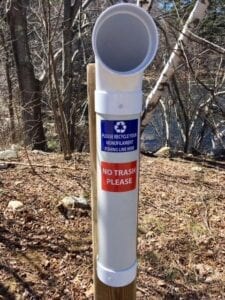Lake Kanasatka has been known to have the following fish species:
Bass
Black Bass
Brown Bullhead
Chain Pickerel
Largemouth Bass
Perch
Pickerel
Pike
Smallmouth Bass
Sunfish
White Perch
Yellow Perch
Loons and Lead Tackle
In 2016, Lake Kanasatka’s male loon was found beached, badly tangled in fishing line. Despite the heroic rescue by John Cooley of LPC, Steve Corcoran and great medical care at Meadow Pond Animal Hospital and Avian Haven in Maine, the loon did not survive, leaving his mate to raise their young chick. Along with the mass of fishing line that entangled the loon, X-Rays showed two different fish hooks in its stomach. No one knows exactly how this tragedy occurred, but one theory is that the loon swallowed fish that were hooked, then snapped the fisherman’s lines, escaping with a length of line attached.
Was this loon’s death preventable? Absolutely! It is a mystery how a loon can become entangled in that amount of broken fishing line and end up with two different hooks in its  stomach. Fishermen tend to fish with just one hook. Hooks are designed to corrode very quickly, so they are not the biggest problem. Lost or discarded fishing line remains a hazard to wildlife for many years.
stomach. Fishermen tend to fish with just one hook. Hooks are designed to corrode very quickly, so they are not the biggest problem. Lost or discarded fishing line remains a hazard to wildlife for many years.
While fishing line is quite durable, there are many reasons why it could break. I researched this topic via the Internet and found many causes of mono-filament line failure. There are simple tests to check the condition of rod, reel and line, along with suggested solutions to the problems. Ultraviolet Rays from the sun and/or extreme heat can ruin line. Store rods and spare line out of the sun, away from bright light, avoid hot boats, car trunks, or similar storage places. Expert fishermen recommend storing your fishing gear in a cool, dark place. Think about where your fishing gear sits all summer. If you think this is extreme advice, I urge you to check the fishing blogs on the internet. They take it very seriously. Line weakens over time. Fishing line manufacturers recommend discarding line after 2-3 years. You can find the manufacture date of your line on the spool label, right under the lb. test rating. When buying line, check the date. Beware of discounted fishing line, it might be old. Buy quality line. Replace the line in your reel every season.
Nicks, cuts, and abrasion are probably the greatest cause of line breakage. Inspect the first few feet of your line frequently, especially after catching a fish, or recovering a snag. Use a magnifying glass or reading glasses for visual inspection if necessary, or pinch the line between your fingers and slide it through your fingers to feel for damage. If the line feels rough, cut off approximately 10 ft. of line, check it again and retie your hook or lure. Look at your fingers after performing the pinch test. If you see a whitish residue, your line is corroding and will be weaker. Stretching. When mono-filament line is pulled taut and stretched hard, as in some snag situations, the molecular structure of the line can change, leaving the line thinner and less flexible. Under high magnification, stretched line looks like alligator skin. Hooking the lure onto an eyelet and reeling the line tight for storage is not recommended. The hook(s) can damage the eyelet and during storage, the top eyelet can make a dent in the line being forced against the eyelet, leaving a weak spot in the line. Rods come with built-in hook keepers located just in front of the handle for attaching the hook or lure for storage. Snug the line, but not so tight that it bends the rod. Snags might be the leading cause of broken fishing lines. Pulling hard on a snagged line is not recommended, for some of the reasons above. I have found the most common snag in Kanasatka occurs when a lure or other sinking bait gets trapped between two rocks during slow retrieve. If you think about how this happens, it makes sense to back the lure out of where it is stuck, by simply circling the boat around, getting behind the area where the line extends out of the water, and lifting the lure out of the crevice. This is simple from a boat, but a little more time consuming from land. One would have to paddle a small boat out to the area. I have done it often. It is not convenient, but it is the right thing to do.
Inspecting a rod and reel are equally important. Damaged eyelets will damage the line that passes through them. Slide a cotton Q-Tip in and out of each eyelet. If the cotton catches on anything, the eyelet is damaged and will cause damage to the line. Reeling the lure, weight or hook up tight, to the end eyelet for storage could also damage the eyelet. Inspect areas of the reel which come in contact with the line, specifically the spool, bale and line roller on a spinning reel. Any nicks in the metal will damage the line. Finally, proper disposal of unwanted fishing line is crucial. Line left on a dock or inside a boat can easily blow into the water. Together, we can make a difference.
Fishing Line recycling

Lisa Hutchinson’s father made this fishing line recycling container for us. They are used all over the country. We received approval from NH DES and NH Fish and Game to install it at the Rte. 25 boat ramp. It is mounted on a pressure treated post and should be very durable. Last year we lost our male loon after it ingested discarded fishing line and hooks. Please use this to recycle your old fishing line and keep our lake clean.
Fish Lead Free
 New Hampshire State Law prohibits the use of lead jigs less than one inch in length and sinkers weighing one ounce or less.
New Hampshire State Law prohibits the use of lead jigs less than one inch in length and sinkers weighing one ounce or less.
Effective June 2016 the sale and freshwater use of lead fishing sinkers and jigs weighing one ounce or less will be banned in New Hampshire. NH LAKES, along with a coalition of groups including The Loon Preservation Committee, help pass this important safeguard to protect our loons and aquatic wildlife.
Why Fish Lead Free?
Fishing lead free is better for our lakes and our wildlife. Ingested lead fishing tackle is the leading cause of death for adult Common Loons, but also affects many other species of wildlife in New Hampshire.
Angler’s Guide to Lead-Free Fishing
Non-toxic tackle comes in many metal choices and modern metal alloys offer the angler a number of advantages. For information on where to buy lead free fishing tackle and where to dispose of lead tackle in New Hampshire, visit fishleadfree.org/nh/
NH Fish Consumption Guidelines
Going Fishing? Are you concerned about the mercury level in the lake’s fish? How much fish is safe to eat? Click Here to navigate to NHDES Mercury in Fish website page.
